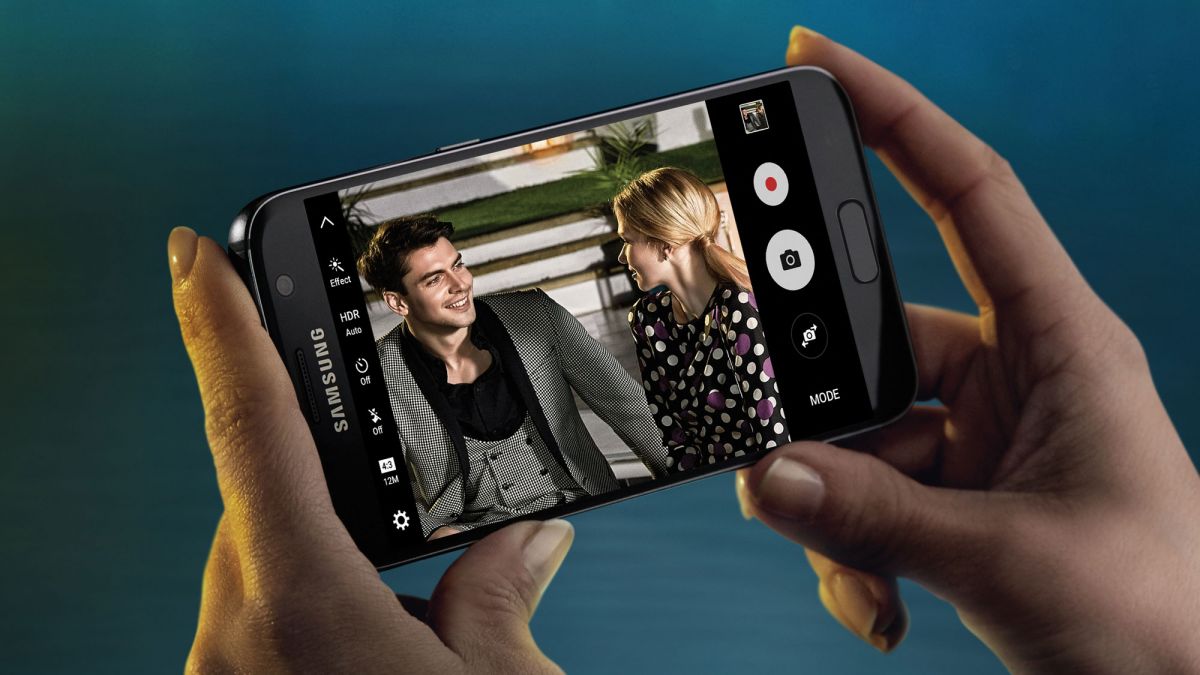Introduction, design and screen
Samsung’s flagship smartphone has arrived and it once again comes in two distinct flavors, forever complicating your Android upgrade decision-making process.
Okay, maybe not forever complicating it. But it’s not easy to pick between the Samsung Galaxy S7 and its curvier cousin, the Galaxy S7 Edge. They rank one and two on our best phones list.
The good news is that there are notable differences between the pair, unlike the Galaxy S6 and S6 Edge a year ago. It’s more than just a gentle curve on one and not the other this time.
Display size, battery capacity and software really contrast in 2016. You can’t go wrong with either due to their best-in-class cameras, always-on displays, microSD card slot and waterproof features. But there’s only one fit for your hand.
Design
Both the Samsung Galaxy S7 and S7 Edge are made of metal and glass welded together, and it makes for a beautiful smartphone design. The big difference is that the Edge screen wraps around the sides.

The bolder-looking S7 Edge is also a lot bigger this year due to its 5.5-inch display. The entire phone now measures 150.9 x 72.6 x 7.7mm and weighs in at 157g.
It’s not as big or as heavy as last year’s 5.7-inch Samsung Galaxy S6 Edge+, and I found that I could hold and operate it more easily in one hand, albeit still with a lot of finger stretching.
The Samsung Galaxy S7, meanwhile, retains the classic 5.1-inch display and requires very little finger strain to reach the furthest corners. It measures 142.4 x 69.6 x 7.9mm and weighs 152g.
The backs of both phones take cues from the Samsung Galaxy Note 5, which features a slightly curved back around the right and left sides. This made the new Galaxy phones easier to hold in my palm.

Everything else is the same between the two. There’s a fingerprint sensor embedded in the home button, a microSD card slot coupled with the nanoSIM card tray (now at the top), and a waterproof rating of IP68. That means it can soak in water for 30 minutes at a depth of 1.5 meters before taking damage.
The new S7 Edge is extremely attractive and tempting, but at 5.5 inches, it’s not for everyone. People with small hands will want to opt for the more practical S7.
Screen
The S7 and S7 Edge screen sizes differ by 0.4 inches, and that’s enough to make small-handed humans running away from Samsung’s bigger and curvier smartphone.
Anyone who can handle the roomier display size will be treated to one of the best in a phone, right up there with the 5.7-inch Galaxy Note 5. Its larger size maximizes your enjoyment.

Of course, both the 5.1-inch and 5.5-inch phones have excellent screen technology backing up their crisp-looking panels. Samsung uses a Super AMOLED display that’s a pixel-dense quad HD.
That means the S7 and S7 Edge resolution is once again 2,560×1,440, but the vibrant colors seem punchier this year and the brightness has been kicked up a notch. The sun is hardly a match the duo.

There’s also an always-on display, which means the phone never actually goes to sleep. It leaves a few pixels to show the time, date, battery percentage and a few notification icons.
That’s extremely convenient since the screen consistently presents this dimly lit glanceable information at all times, and turns off almost every other pixel on the display, essentially sipping battery life.
Software, media and performance
Interface and apps
These are the first Android 6.0 Marshmallow phones, although you wouldn’t really know it since the latest form of TouchWiz occupies the interface. The good news? It’s quite good.

Samsung has cleaned up its operating system overlay so that it’s no longer overbearing with so many options. It has friendlier colors, a simpler design scheme and an overall more inviting look.
The S7 and S7 Edge run an identical version of Android 6.0.1, but the software isn’t exactly the same. Samsung uses the S7 Edge’s curved side to add in a few extra menus and shortcuts.
Swiping open the Edge UX menu system from the right side first reveals Apps Edge, which is a panel of ten frequently used apps. A second swipe shifts the menu to Taks Edge, another ten shortcut buttons to specific functions like “Taking a selfie” or “Set the Stopwatch.”

A third swipe from the right side reveals People Edge, which is a handy way to call, text or email your favorite contacts, though it’s limited to five people.
Yahoo News and the weather are the remaining Edge UX menu defaults, although there are a bunch of panels like sports scores and a compass in the settings menu, and even more you can download later.
That said, I’ve never found the Edge UX – even with new panels available – to be groundbreaking. The interface between the two shouldn’t sway your decision as much as the actual screen size.
Media
The thought of watching a movie or playing a game on a curved display seems unnatural, but the truth is that the Samsung Galaxy S7 Edge slopes ever-so-gently on the right and left sides.
Powering through an episode of House of Cards Season 4 on the 5.5-inch S7 Edge phone didn’t bother me at all. In fact, I appreciated it more than when I watched it on the 5.1-inch S7.

I felt the same way when playing Real Racing 3, my go-to game for testing 3D performance. Taking sharp in-game turns on the more spacious display felt easier. Consider me a fan of the bigger screen.
What I didn’t like about either phone is the single speaker grill on the bottom of the frame. I would have preferred stereo front-front speakers here.
Watching movies and listening to music doesn’t sound any worse than any other smartphone with the mono speaker pointed in the wrong direction. I can crank up the volume just fine.

It’s more of a problem when playing games. My hand often covers up the bottom frame of the phone, muffling the background music and racecar-motoring sound effects.
It’s not surprising. Only a few HTC, Sony and Motorola phones have speakers on the front. It’s just that Samsung makes a big deal about gaming with its Game Launcher container app, but it’s not “all in” when it comes to providing an all-round multimedia experience.
Specs and performance
There are no differences between the S7 and S7 Edge when it comes to chip performance and specs. They have all of the same internals, starting with the brand new System-on-a-Chip.

You’re either getting the Qualcomm Snapdragon 820 processor with an Adreno 530 GPU in the US, or Samsung’s own Exynos 8890 chip with a Mali-T880 MP12 GPU everywhere else.
Samsung’s Exynos chip actually did better in our benchmarking tests when compared to our US phones with the Qualcomm processor. But it makes little difference day-to-day. They’re both record-breaking silicon and every variation of the phone contains 4GB of RAM.
What’s more is that you’re not going to be able to simply buy one over the other, unless you’re on a shopping spree while globetrotting. It’s a case of where you buy the handset due to the US edition needing CDMA (Verizon and Sprint) carrier bands. And, again, the S7 and S7 Edge are exactly the same here.
Battery life and camera
Battery life
There’s one and only one thing that’s not equal inside these two Samsung Galaxy phones: the battery capacity. As you might expect, the larger handset has a slightly bigger battery.
The Galaxy S7 Edge packs in a heftier 3,600mAh battery, while the standard S7 comes with a still-healthy 3,000mAh. It’s actually still remarkable Samsung could fit that in a 5.1-inch phone.

To thoroughly test the battery, I initially played a 90-minute HD video, and the Galaxy S7 went from 100% to 84% representing a 16% drain. The Edge held to 86% for a 14% during the same test.
I found similar results going a full day with both phones (on opposite days for proper testing, of course) without completely draining either battery. The Galaxy S7 drained to 13% by the end of the day, while the S7 Edge fared better at 17%. It’s a small, but meaningful difference.
Is the 3,000mAh S7 totally inferior to 3,600mAh S7 Edge? Should you be worried? No, because the larger Edge has to power than bigger 5.5-inch display, after all, narrowing its victory a bit.
There’s also Fast Charging on each phone. I was able to replenish 25% of the S7 battery and 23% of the S7 Edge battery in 15 minutes. It took 1 hour and 29 minutes to fully charge the S7, and 1 hour and 38 minutes to do the same for the larger S7 Edge.
You have to look at it all this way: both phones have bigger batteries than their S6 and S6 Edge predecessors, so you’re going to get more juice out of the S7 and S7 Edge, regardless.
All four of these phones drained around the same amount in our 90-minute battery tests, but Samsung has improved the standby time battery life since last year, similar to how Google’s Nexus phones use Doze mode.
Even with the always-on screen, I have gotten better battery life from the new phones, while the S6 and S6 Edge have gone dead on me before bedtime too many times to count.
Camera
The Samsung Galaxy S7 and S7 Edge cameras are the absolute best among smartphones, and the company has held this title since early 2015 when the S6 and S6 Edge first launched.


In fact, the older S6 phones beat the even the newer iPhone 6S and 6S Plus when they launched in September. Samsung has set and cleared its own bar with these new cameras.
All of this may be confusing at first if you look at the specs sheet, because the S7 and S7 Edge feature a 12MP camera instead of a 16MP sensor. But Samsung only dialed back the megapixel count to increase the size of individual pixels.


This has resulted in better low-light performance from the pair of phones, and it shows in each and every restaurant and bar photo.


Between the two I noticed no discernible differences between the photos, even at 100% crop. The cameras sensors and software are the same, and that’s what I expected.
However, history has taught me to check. I found minor variations between the Nexus 5X and Nexus 6P, with the latter doing better and faster post-processing work, creating hard-to-spot differences.
Price and verdict
Price
There’s only one way in which the Galaxy S7 has an “edge” over the S7 Edge: It’s cheaper. You pay a price for a chic phone with more pieces of flair.

In the US, the Samsung Galaxy S7 costs $199 upfront on a two-year contract – if you can find it. American carriers have begun phasing out these commitments for device payment plans.
AT&T wants $23.17 a month from you for 30 months. T-Mobile asks for $27.09 a month, Sprint is in that ballpark at $27.91 a month and Verizon charges $28 a month, all for 24 months. There’s no unlocked Galaxy S7 in the US just yet, but it could cost as much as $600 to $650. Samsung may introduce it through its official channels in a few months.
In the UK, the S7 costs an easier-to-understand £569 SIM-free, and in Australia, the price has increased dramatically to AU$1,249.
The S7 Edge declares itself premium not just through design and software, but through price. It costs $100 more, at $299, in the US through a two-year contracts again.
Breaking that into a consumer-confusing monthly payment plan, AT&T has it for $26.50 a month for 30 months, while T-Mobile wants $32.50 a month, Sprint is technically cheapest at $31.25 a month, and Verizon finishes things up at $33 a month, again, all for 24 months. There’s no unlocked Galaxy S7 Edge, either.
In the UK, the S7 Edge costs £640, and in Australia it’s the highest price yet: AU$1,249. No one ever said carrying the flashiest phone around was going to be cheap.
Verdict
Clearly there’s a lot that goes into deciding between the Galaxy S7 and Galaxy S7 Edge, even though the new Samsung phones seem so similar. It matters which one you buy.

I found the 5.5-inch display of the S7 Edge to be manageable enough to hold in one hand and operate properly throughout the day, and I appreciated the extra screen real-estate and curvy look. That said, anyone with smaller hands will naturally prefer the 5.1-inch S7.
The swipe-from-the-side, shortcut-filled Edge UX interface didn’t do much for me and the battery life is only marginally better. Everything else, aside from the price, is the same, including a great camera and meaty specs. It’s going to come down to the size of your hand and the size of your wallet.
Source: techradar.com












































